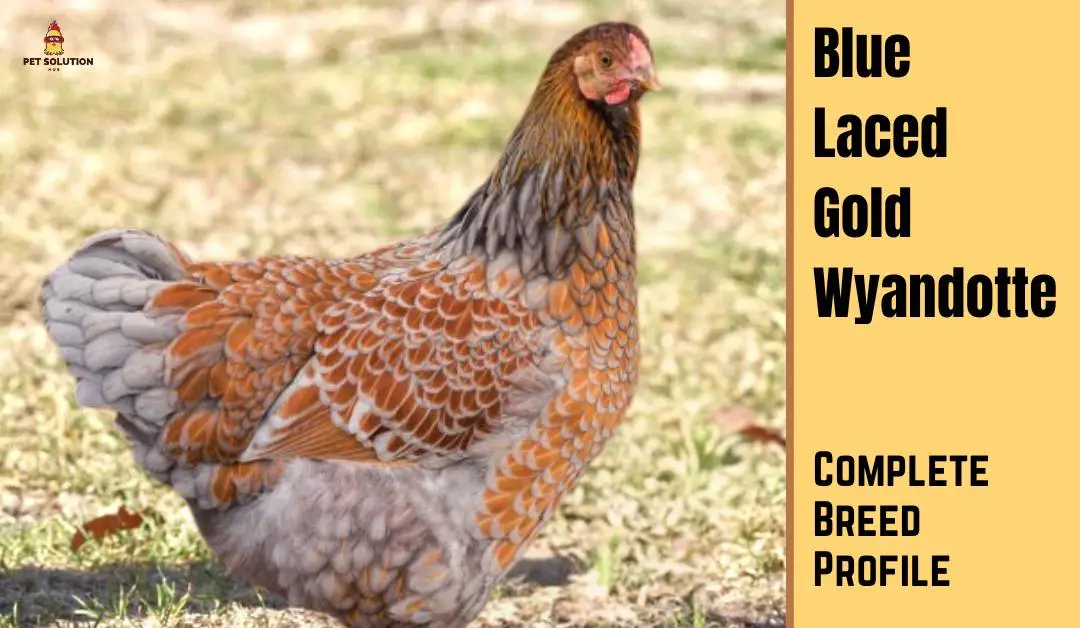Blue Laced Gold Wyandotte is a very rare and beautiful variety of Wyandotte chickens. They look a bit similar to the Golden laced Wyandottes but these chickens have blue shades instead of the black lacing.
They are a eye-catching breed that not only increases the charm of your flock but will also produce a good number of eggs for you. So, let’s look at the history, temperament, appearance, egg production, and care guide of the Blue Laced Gold Wyandotte Chicken.
Origin and History
Blue Laced Gold Wyandotte is a distinctive variety of Wyandottes. Their history is also very interesting.
Wyandottes were developed in the 18th century. They are considered the first-ever dual-purpose breed in the United States of America. However, they came into being by crossing Brahma chickens with Silver Spangled Hamburgs.
These birds became popular due to their dual-purpose nature as they were excellent in both egg and meat production. Silver laced was the first variety of these chickens but nowadays a lot of new varieties are present including the Blues Laced Gold Wyandottes.
Blue Laced Gold Wyandotte Overview
| Name | Blue Laced Gold Wyandotte Chicken |
| Breed | Wyandotte Chicken |
| Origin | USA |
| Beginner Friendly | Yes |
| Primary Uses | Dual-purpose Breed |
| Egg color | Light brown |
| Egg Production | 200-240 eggs per year |
| Egg Size | Large |
| Lifespan | 5 – 8 years |
| Temperament | Friendly (Roosters are a bit aggressive) |
| Weight | Hen 4-5 poundsRooster 7 pounds |
| Cold Tolerant | Yes |
| Heat Tolerant | No |
| Noise Level | Moderate |
Appearance of Blue Laced Gold Wyandotte Chickens
Blue-laced gold Wyandottes are elegant chickens that look similar to golden-laced Wyandottes. The main trait that sets them apart from other variations of this breed is their unique blue or pale blue lacing instead of the regular black lacing. The feathers on the tail mostly have a solid blue shade.

The feather edges have continuous blue-black lacing, while the overall body feathers are gold, giving these birds a stunning look.
Their waddles are medium-sized and have a rose-type comb which protects them from frostbite during winter. They have four toes and clean legs. Their eyes are also bright.
Weight
Blue Laced Gold Wyandotte are medium-sized chickens. Due to their unique curvy-round plump shape, they look bigger and heavier than their actual weight. However, they are a bit smaller than the golden-laced Wyandottes.
- The Roosters of this breed can weigh between 6 -7 pounds
- The Hens weigh between 4 – 5 pounds.

Color Varieties
Blue Laced Gold Wyandotte Chicken is a popular color variation of the Wyandotte Chickens. However, more than 30 varieties of this breed are present, and almost 18 colors are recognized by the American Poultry Association (APA) in the United States of America. Some famous variations of these chickens are,
- Silver Laced Wyandotte
- Golden Laced Wyandotte
- Black
- Buff laced
- White
- Partridge
- Silver Penciled
- Colombian
- Blue laced red
The Personality of Blue Laced Gold Wyandotte Chicken
Temperament & Behavior
Blue Laced Gold Wyandotte chicken has a calm and polite temperament. They can also easily adjust and mix with the other chickens in your flock. But they don’t like to socialize much and enjoy their own company.
They are a non-aggressive breed and show good behavior with the other breeds of your flock. However, in some rare cases, like any other breed, the roosters can get a bit aggressive, but the hens are always calm and polite.
Lifespan
The average lifespan of these elegant chickens is 5 to 8 years, but it will depend on some major factors like their feed, living environment, diet, and veterinary care.

Noise Level
Wyandottes are typically calm and polite chickens that don’t like to make loud noises. The roosters can make some noise during forging, but overall, they are considered a polite chicken breed.
Hardiness
Blue laced gold Wyandottes are a very cold-hardy breed. Their thick feathers help them to survive easily in extreme cold weathers. Their rose comb protects them from frostbite in winter. However, they can face difficulty in areas with very hot climate
Blue Laced Gold Wyandotte Chicken – Egg and Meat Production
These chickens are mostly used for both egg and meat production. They are famous in America for their dual-purpose nature. They are also considered the first-ever dual-purpose chicken breed in America.
Egg Production
The blue-laced gold Wyandotte hen can lay 4 to 5 beautiful large cream or light brown color eggs. Their hens normally start laying eggs at the age of about 6 months and you can expect almost 200-240 eggs per year.
- Egg size: Large
- Egg Color: Brown or Cream color
- Eggs per week: 4-5
- Eggs per year: 200-240
- Age of starting laying eggs: 6 months
Meat Production
These chickens are also popular for their meat production. They can grow up to 7 pounds, and many people only keep them for meat purposes. Their meat is also flavorful, which increases their importance in the meat industry.
How to Raise Blue Laced Gold Wyandotte Chicken?
Care & Protection
Blue laced gold Wyandotte chicken is a robust breed that usually doesn’t get sick easily. They are extremely cold tolerant, and are not prone to frostbite due to their rose-type comb.
But they require extra care in summer because excessive heat could be harmful for their health. Keep them in shady places, and water should be available 24/7. Give proper vaccinations to the chicks and keep their coops clean and parasite-free.

Housing or Coop Setup
Wyandottes require a clean and airy house to grow properly and produce healthy eggs. Normally, a 4 to 6-square-foot coop is ideal for these chickens. However, you can expand their space depending on the land available to you.
Conclusion
Blue Laced Gold Wyandotte can be an ideal chicken for you that can enhance the beauty of your flock with its unique and attractive colorations. They are polite and docile and also behave well with other chicken breeds. You can keep them for both egg and meat production.
In short, blue-laced gold wyandotte is a great chicken, and every poultry enthusiast will love to add these chickens in their backyard.

